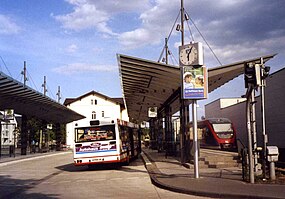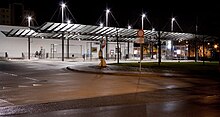Eschweiler valley station
| Eschweiler valley station | |
|---|---|

Combined platform of today's Eschweiler Talbahnhof / Raiffeisenplatz station
|
|
| Data | |
| Operating point type | Passenger station |
| Location in the network | Intermediate station |
| Design | Through station |
| Platform tracks | 1 |
| abbreviation | KET |
| IBNR | 8001888 |
| opening | October 1, 1873 September 11, 2004 |
| Conveyance | May 23, 1983 |
| location | |
| City / municipality | Eschweiler |
| country | North Rhine-Westphalia |
| Country | Germany |
| Coordinates | 50 ° 48 '53 " N , 6 ° 15' 50" E |
| Railway lines | |
| Railway stations in North Rhine-Westphalia | |
The Eschweiler Talbahnhof is a train station on the Mönchengladbach – Stolberg railway in the southern city center of Eschweiler in the Aachen region . It was opened as Eschweiler BME station in 1873 and closed for passenger traffic in 1983, and also for freight traffic at the end of the 1980s. In 2004 the EVS Euregio Verkehrsschienennetz reopened it as a stop at Eschweiler Talbahnhof / Raiffeisenplatz . In 2009 it was again converted into a train station with the possibility of crossing.
In the reception building of the former Talbahnhofs now houses a cultural center . Many locals emphasize the name Talbahnhof on the second instead of the first syllable.
history
Bergisch-Märkische Railway Company
The interim name Eschweiler Thal - later Eschweiler Tal - comes from the fact that the Inde still sought its way in the 800 m wide Indemulde valley between Eschweiler- Röthgen and the old town until the beginning of the 19th century. The river had several arms in the plain, which at the time had many moors and swamps. The southern arm ran roughly where the Talstrasse runs today (from 1883 to 1898 Bahnstrasse), which was laid parallel to the railway line from 1872 to 1873 in an east-west direction.
On October 1, 1873, the Rheydt - Odenkirchen - Hochneukirch - Jülich - Frenz - Inden - Weisweiler - Eschweiler-Aue line was opened with a total length of 48.77 km by the Bergisch-Märkische Eisenbahn-Gesellschaft ; the two train stations in Eschweiler area were Eschweiler-Aue in the Aue district and Eschweiler Tal. In 1872, around the same time, the new station building of Eschweiler Hauptbahnhof was built. The Weisweiler train station , which is also on the valley railway line , only became part of the city on January 1, 1972 when the local authority was restructured.
Second World War
In 1937 the construction of the west wall began in the Aachen region. The valley station was used as an unloading station for gravel transports during the construction work. The gravel was transported continuously to the Siegfried Line construction sites by truck. On the occasion of this construction work, a tank loading ramp was built, which was also used by the Belgian armed forces after the Second World War - in addition to private use (e.g. agricultural and construction machinery, circus) .
Towards the end of the Second World War, the front line moved from the west towards Eschweiler. In autumn 1944, rail traffic on the valley railway was stopped. In the ensuing fighting, the building was badly damaged by shell fire. After the occupation of Eschweiler by US troops, the valley railway and Eschweiler Tal station were resumed on March 4, 1945.
post war period
At the end of the 1960s, the opposite mechanical signal box with barrier posts was demolished. Eschweiler Tal received a porch on the platform side with a table. The duties of the dispatcher were also assigned to the officer on duty.
The station building, which was damaged in the war and now owned by the Deutsche Bundesbahn , which had been founded in the meantime, had not been renovated. The cost of the renovation in 1960 would have been 40,000 D-Marks and were estimated at around 80,000 D-Marks in 1972 due to the inflation that occurred during the period of the economic miracle . While the reconstruction of the city was largely complete in the early 1970s, the station was increasingly perceived as an eyesore. Therefore, considerations began to demolish the reception building. Instead, a “disproportionately smaller, purely functional building” with a waiting room and ticket sales was to be created. The construction costs for this building were put at 100,000 D-Marks; the cost of demolishing the old station building is estimated at 30,000 Deutschmarks. However, the Federal Railroad did not have this money, and the proposal by the city of Eschweiler to bear the costs for the demolition of the reception building was not accepted. Since the continued existence of the building was unclear, the Federal Railroad also refused to renovate the old valley station. Because of this situation, the plans to build a new building were discarded; the facade was renovated in the summer of 1976.
On May 22nd (other sources: 27th) May 1983, the valley railway line in the direction of Jülich and Aachen was closed for passenger traffic and the Eschweiler Tal station was closed. The buses of the Aachen transport association took over the rail traffic . The roundabout with a round fountain and the small bus station were demolished a few years later and replaced by a park.
Use as a cultural center
The building was added to the list of historical monuments in 1987. Following a proposal from 1989, the Eschweiler city council decided in 1991 to buy the building from the Federal Railroad. From 1993 to 1994 a cultural center was set up in the station building with a bistro, cabaret and rooms for the art association founded in 1982 and the Eschweiler history association . It opened on November 19, 1994. Since then, there have been regular meetings of various associations, lectures, song recitals, cabaret, author readings, chamber concerts, exhibitions and other events.
Euregiobahn stop
On September 11, 2004, the Eschweiler-Talbahnhof / Raiffeisenplatz stop was opened as the successor to the Eschweiler Tal station . This is a few meters west of the old station from the Federal Railroad era. The stop was given a new combined platform ; the form signals and the signal box front on the old station building were dismantled and removed. At the same time, the square in front of the valley station was renamed Raiffeisenplatz because Raiffeisen-Bank Eschweiler played a key role in financing the reconstruction of the square.
The construction work was finished in August 2006: At the site of the park there is again a small bus station with five bus platforms and two steel structures as a roof. The Carbyn memorial was placed in the small park on the other side of Franzstrasse and the Einhard memorial back in the city garden.
On June 10, 2009 the previous stop went back into operation as a train station after a renovation block. The intersection is not on the platform, but in the area of the former freight station. A crossing and passing track that is connected on both sides and secured with signals has been set up there. At the same time, light signals ( System Ks ) were set up, which, like the two points, are remotely activated by the EVS electronic signal box in Stolberg's main train station .
See also
literature
- Series of publications by the Eschweiler History Association, Volume 14
- Eifelverein Eschweiler, Discover Eschweiler, Düren 2002
Web links
- Current departure plan from Eschweiler valley station. Deutsche Bahn , accessed on January 29, 2016 .
- Departure monitor. Exit Eschweiler, Talbahnhof / Raiffeisen-Platz (bus). Aachen Transport Association , accessed on January 29, 2016 .
- Eschweiler-Talbahnhof / Raiffeisen-Platz. (PDF file; 340 KB) In: Stop location plans. Aachen Transport Association , June 2015, accessed on January 29, 2016 .
- Reinhard Gessen: Railway stations - Eschweiler valley station. In: Mining and railways in the Aachen-Düren-Heinsberg region. Reinhard Gessen, accessed on January 29, 2016 .
- André Joost: Eschweiler valley station operating point. In: NRWbahnarchiv-Betriebsstellearchiv. André Joost, accessed January 29, 2016 .
- André Joost: Eschweiler valley station train station. In: NRWbahnarchiv-Bahnhofsinfo. André Joost, accessed January 29, 2016 .
Individual evidence
- ↑ Overview of the operating points and their abbreviations from Directive 100. (PDF file; 744 KB) DB Netz AG, August 2015, p. 39 , accessed on January 3, 2016 .
- ↑ a b Eschweiler valley station. Cabaret Initiative Euregio e. V., accessed on January 29, 2016 .
- ↑ The valley station as it was in May - the facade still shows signs of war damage after 25 years. Aachener Volkszeitung No. 193, August 24, 1970.
- ^ Marie-Luise Herrmann, Adam Elsen: Eschweiler after the occupation by American troops. In: Series of publications by the Eschweiler history association. No. 15, 1994, ISSN 0724-7745 , p. 11.
- ↑ Correspondence between the Eschweiler city administration and the Deutsche Bundesbahn 1972–1976; can be viewed in the archive of the Eschweiler history association .
- ↑ Now the Euregiobahn rolls into the valley station. In: Aachener Nachrichten . September 10, 2004, accessed January 29, 2016 .


